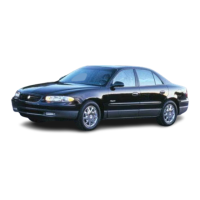
Do you have a question about the Buick 1999 Regal and is the answer not in the manual?
| Brand | Buick |
|---|---|
| Model | 1999 Regal |
| Category | Automobile |
| Language | English |
Information on using seats and safety belts, including air bag system.
Guidance on starting and operating the vehicle.
Instructions for adjusting comfort controls and operating the audio system.
Tips for driving under various conditions and on different roads.
What to do when facing issues like a flat tire or overheated engine.
Guidance on maintaining vehicle appearance and performance.
Information on when to perform vehicle maintenance and fluid usage.
How to contact Buick for assistance and report safety defects.
Explanation of safety cautions and symbols used in the manual.
Details on adjusting manual and power seats, including specific types.
Guidance on proper safety belt usage and things to avoid.
Instructions for adult safety belt use, focusing on driver position.
Explanation of the vehicle's 'Next Generation' frontal air bag system.
Importance of rear seat passengers buckling up and safety belt usage.
Guidance on protection for infants, small children, and babies.
Information on different types of child restraints and their usage.
Recommendations for placing child restraints safely in the vehicle.
Guidance for children who have outgrown child restraints.
Information on using a safety belt extender if the standard belt is too short.
How to check safety belts, buckles, and air bag covers for proper function.
Guidance on replacing safety belts and air bag system parts after a collision.
Information on ignition and door keys, and precautions for leaving keys in the vehicle.
Details on how to lock and unlock doors, and safety precautions.
Explanation of programmable automatic power door lock modes.
How to use child security locks to prevent rear door opening from inside.
Operation of the remote keyless entry system for locking/unlocking doors and trunk.
How to activate the vehicle alarm using the remote keyless entry transmitter.
Customizing audible/visible feedback for lock/unlock commands.
Feature allowing doors to lock after passengers exit, with customizable options.
Feature providing interior lighting upon remote keyless entry unlock.
Guidance on replacing the battery in the remote keyless entry transmitter.
Information on trunk operation, locking, and safety precautions.
Vehicle theft deterrent features and advice on preventing theft.
Warning about leaving keys in the ignition and theft-deterrent reminders.
Explanation of the passive theft-deterrent system using an ignition key.
Guidelines for breaking in a new vehicle for optimal performance.
Description of the five ignition key positions and their functions.
Step-by-step instructions for starting the V6 engine.
Information on using the engine coolant heater for cold weather starting.
Explanation of automatic transaxle operation and gear selection.
How to set and release the parking brake and associated warnings.
Procedure for safely shifting into PARK, including safety precautions.
Safety precautions and procedures for leaving a vehicle with the engine running.
Instructions and troubleshooting for shifting out of PARK.
How to use the electric park lock system and override slots.
Safety warning about parking over combustible materials.
Safety warnings about engine exhaust and carbon monoxide.
Tips and safety advice for idling the engine when parked.
Operation of power windows, including driver controls and features.
How to operate the vehicle's horn.
Instructions for adjusting the tilt steering wheel for comfort and entry/exit.
Controls for turn signals, headlamps, wipers, and cruise control.
Controls for various exterior lamps, including headlamps and parking lamps.
Operation of DRLs and automatic headlamp control based on light conditions.
Customizing exterior lighting that remains on after leaving the vehicle.
How to turn fog lamps on and off, and their operating conditions.
Functionality of cornering lamps that activate when signaling a turn.
Controls for interior lighting, including instrument panel brightness.
Automatic interior lighting when doors are opened or manually turned on.
Interior lighting that stays on after unlocking or opening doors.
Interior lighting that remains on after the ignition key is removed.
Exterior vehicle lighting activated when approaching the vehicle.
How to turn on and off the reading lamps in the rearview mirror.
Automatic dome lamp activation when doors are opened.
Feature preventing battery drain from accidentally left-on interior lamps.
Allows power windows, audio, and sunroof to work after ignition is turned off.
Guidance on adjusting mirrors for clear visibility and driving position.
Operation of the auto-dimming mirror to reduce glare from headlights.
Instructions for operating power mirrors, including folding and adjustment.
Feature for driver's side mirror auto-dimming and heating.
Description of the passenger side mirror's convex surface and safety caution.
Locations and operation of storage compartments like the glove box and center console.
How to open and lock the glove box.
Description of console features including cupholders and storage area.
Accessing the trunk via the rear seat pass-through feature.
How to use the trunk convenience net for securing small loads.
Location and use of ashtrays and the cigarette lighter, with safety notices.
How to use sun visors, including their movement and vanity mirrors.
How to expose and use the vanity mirror, including optional lighting.
Using the 12-volt outlet for aftermarket electrical equipment.
Accessing power, ground, and accessory wires for aftermarket equipment.
Operation of the express-open astroroof, including glass panel and sunshade.
Overview of available OnStar services like emergency and roadside assistance.
Overview of instrument panel components and their functions.
Description of the instrument cluster gauges for monitoring vehicle operation.
How to read the speedometer and odometer, and tamper-resistance features.
Explanation of the tachometer's function and engine speed display.
Understanding warning lights and gauges for vehicle status.
Function of the safety belt reminder light and associated chime.
Meaning of the air bag readiness light and what to do if it stays on.
Indication of charging system issues and potential causes.
Function of the brake system warning light and associated cautions.
What the ABS warning light signifies and how to reset the system.
Reasons for the traction control system warning light to come on.
Indicator for when the traction control system is limiting wheel spin.
When the low traction light comes on and what it indicates.
Indicates engine coolant overheating or cooling fan malfunction.
How to read the engine coolant temperature gauge and what the red area means.
Indicates low coolant level and potential engine overheating.
Alerts to changes in tire pressure, indicating potential underinflation.
Indicates a problem with fuel, ignition, or emission control systems.
Indicates a low oil level or other oil system problems requiring immediate attention.
Warns of low engine oil level detected by the oil level monitoring system.
Indicates when the engine oil needs changing based on vehicle computer data.
Indicates the status of the PASS-Key II system and potential key issues.
Indicates when the cruise control system is engaged.
Indicates when the vehicle is in performance shifting mode.
Alerts to non-emission related vehicle problems affecting performance or durability.
Indicates a low fluid level in the windshield washer fluid container.
Indicates if the trunk or any door is not completely closed.
How to read the fuel gauge and normal operating characteristics.
Indicates when the fuel level is low, accompanied by a chime.
Display of safety and maintenance facts, including average fuel economy.
Buttons for controlling the Driver Information Center functions (Mode, Reset, E/M).
Operation of the Dual ComforTemp Climate Control system.
How to select fan speed and information on replacing the air filter.
Setting driver outlet temperature by turning the center knob.
Adjusting passenger side temperature independently.
Controlling airflow direction using the mode knob.
Tips for efficient cooling, including MAX and NORM settings.
Using the HTR setting for heat and the engine coolant heater.
Using the VENT setting for outside air and flow-through ventilation.
Settings for clearing front and side windows quickly.
System for maintaining separate driver and passenger temperatures.
Using AUTO mode for efficient climate control operation.
Using the TEMP switch for system temperature and manual control.
Manually controlling airflow direction, fan speed, and air sources.
How to turn the rear defogger on and off, and its operation.
Adjusting airflow direction and tips for effective ventilation.
Overview of the Delco Electronics audio system and its controls.
Instructions for setting the clock to display the correct hour and minute.
Features of the AM-FM stereo system with cassette and automatic tone control.
How to turn the system on/off and adjust volume.
Methods for finding radio stations using tuning, seeking, and scan functions.
How to set and use pushbuttons for favorite radio stations.
How to listen to preset stations for a few seconds using P SCAN.
Automatically seeking and setting FM or AM stations on preset buttons.
Adjusting bass and treble, and using preset tone settings.
Adjusting speaker balance (left/right) and fade (front/rear).
How to insert and play cassette tapes, troubleshooting errors.
How the THEFTLOCK feature deters radio theft using a secret code.
Step-by-step instructions for entering a secret code to activate THEFTLOCK.
Procedure for unlocking the radio after battery power interruption.
Steps to disable the THEFTLOCK system by entering the secret code.
Using steering wheel buttons to control radio functions like seeking.
How to use the SCAN button to scan through preset radio stations.
How to switch between AM, FM1, and FM2 bands.
Changing audio source between radio, cassette, and compact disc.
How to silence the audio system temporarily.
How to increase or decrease audio volume.
Information on AM and FM radio reception characteristics.
Precautions regarding hearing damage from loud noise and volume control.
How to clean and maintain the cassette tape player for optimal performance.
Proper handling and storage of compact discs to prevent damage.
Advice on cleaning the CD player's lens and avoiding risks.
Information about the AM-FM antenna integrated with the rear window defogger.
Explanation of antenna placement in windshield and rear window.
Key advice for safe driving: anticipate others, maintain distance, and stay focused.
The dangers of drinking and driving, and its impact on reflexes and judgment.
Understanding the three systems (brakes, steering, accelerator) that control vehicle movement.
Explanation of perception time, reaction time, and stopping distances.
How the ABS system works to prevent braking skids and its self-check.
Information on power steering, magnetic variable effort steering, and steering tips.
How to recover a vehicle when its wheels have dropped off the road.
Tips for safely passing another vehicle on a two-lane highway.
What to do in an emergency when control is lost, focusing on steering.
Understanding types of skids and how to handle them by easing off the accelerator.
Tips for safer night driving, including defensive driving and visibility.
Advice for driving in wet conditions, including visibility and traction.
Explanation of hydroplaning and factors that increase its risk.
Strategies for increasing safety in city driving, focusing on traffic and signals.
Rules and advice for driving safely on freeways, including speed and lane usage.
Checklist for vehicle readiness and personal preparedness for long trips.
Awareness and tips to prevent falling asleep at the wheel on long drives.
Tips for driving on steep hills and mountains, including gear selection.
Tips for preparing the vehicle and supplies for winter driving.
Precautions for driving on slippery surfaces, including acceleration and braking.
What to do if stranded in a blizzard to stay safe and summon help.
Information on towing the vehicle for recreational purposes.
Guidance on vehicle weight limits, tire loading, and capacity labels.
Safety rules and advice for towing a trailer, including equipment and driving.
Important points for trailering, including laws, sway control, and break-in.
Considerations for trailer weight, tongue weight, and vehicle tire capacity.
Importance of tire inflation and not exceeding Gross Vehicle Weight limits.
Rules for selecting and installing the correct trailer hitch equipment.
How to attach safety chains between vehicle and trailer for secure towing.
Note regarding ABS and not tapping into the vehicle's brake system.
Experience needed for towing, understanding handling changes and responsiveness.
Instructions for backing up with a trailer, emphasizing slow and guided maneuvers.
Advice on making wider turns when trailering to avoid contact with objects.
Checking trailer turn signal functionality and potential issues.
How to manage speed and brakes when driving downhill or uphill.
Procedure for parking a vehicle with a trailer attached on a hill.
How to use hazard warning flashers to warn others and signal a problem.
Using reflective triangles to warn traffic behind your vehicle.
Safe procedures for jump starting a vehicle with a dead or low voltage battery.
Proper towing equipment and safety precautions to avoid damage and injury.
What to do if the engine overheats, including steam warnings and fire risks.
Identifying cooling system components and safety precautions when opening the hood.
What to do if a tire blows out, including front and rear tire failure procedures.
Step-by-step instructions for safely changing a flat tire.
How to access and remove the spare tire and necessary tools from the trunk.
Procedure for securing the flat tire and tools in the trunk after changing.
Diagram and steps for storing the spare tire and associated tools properly.
Information on compact spare tire inflation, usage, and calibration.
Methods to free a stuck vehicle, including 'rocking' and turning off traction control.
Importance of dealer service and using genuine GM parts.
Advice on using proper service manuals and keeping maintenance records.
Engine identification, recommended gasoline octane, and fuel quality advice.
Advice on finding proper fuel abroad and avoiding leaded gasoline.
Instructions for refueling, including safety precautions with gasoline vapors.
Safety precautions for working under the hood, especially regarding electric fans.
Steps to open the vehicle's hood, including primary and secondary releases.
How to check or replace the engine air filter and its safety function.
Location and replacement procedure for the passenger compartment air filter.
Maintenance for supercharger oil, including checks and additions.
Checking engine oil level and the function of the LOW OIL light.
Procedure for checking the engine oil level using the dipstick.
Guidance on when to add oil and how much to add, with a caution against overfilling.
Identifying recommended engine oils using the Starburst symbol and viscosity charts.
Advice against adding anything to engine oil and consulting the dealer.
How the computer monitors oil life and when to change the oil and filter.
When to check and change automatic transaxle fluid and filter.
Procedure for checking transaxle fluid level, with a caution about accuracy.
Instructions for adding transaxle fluid, recommending DEXRON-III.
Importance of the radiator cap for preventing coolant loss and engine damage.
How the thermostat controls engine coolant temperature and replacement recommendations.
Information on DEX-COOL coolant, its lifespan, and adding coolant.
How to check coolant level when the engine is cold or warm.
Procedure for adding coolant to the recovery tank or radiator, with safety warnings.
When to check power steering fluid and how to check the level.
What to use for windshield washer fluid and how to add it.
Information on brake fluid, its level, and warnings about wrong fluid types.
How to identify worn brake pads and the importance of timely replacement.
What to do if the brake pedal doesn't return to normal height or travel increases.
Importance of using approved GM replacement parts for brake system components.
Information on the ACDelco Freedom battery and its replacement.
How to prepare the vehicle for storage and battery care during storage.
Directions for changing bulbs, including headlamps and halogen bulb precautions.
Procedure for removing and replacing headlamp bulbs and assemblies.
How to adjust headlamp aim, factory settings, and when to seek professional service.
Replacing bulbs for front parking and turn signal lamps.
Procedure for replacing the bulb in the center high-mounted stoplamp.
Steps for removing and replacing tail, stop, and turn signal lamp bulbs.
Procedure for replacing bulbs in the trunk lid applique.
Replacing back-up lamp bulbs located in the trunk lid applique.
Procedure for replacing the dome lamp assembly and bulb.
Instructions for inspecting and replacing windshield wiper blades.
Information on tire quality, maintenance, and safety precautions.
Importance of correct tire inflation and how to check pressure.
How the low tire pressure warning system works and when to reset it.
Recommended intervals for tire rotation and inspection for wear or damage.
How to identify when tires need replacement based on treadwear indicators or damage.
Advice on selecting new tires, including TPC Spec numbers and load ratings.
Explanation of tire grading systems for treadwear, traction, and temperature.
Importance of proper wheel alignment and balance for tire life and vehicle performance.
When to replace wheels, bolts, or nuts, and using GM original equipment parts.
Warnings about using tire chains, especially with compact spare tires.
General advice on cleaning products, and a list of substances to avoid.
Tips for cleaning interior surfaces like vinyl, leather, and fabric.
Using multi-purpose cleaner on fabric and carpet for normal spots and stains.
Methods for removing specific stains from fabric and carpet.
How to clean vinyl surfaces with water, soap, and specific cleaners.
Proper cleaning methods for leather, including what cleaners to avoid.
Using mild soap and water for cleaning instrument panel surfaces.
Using mild soap and water for cleaning interior plastic parts.
How to clean safety belts safely and what to avoid, like bleaching.
Cleaning interior glass, warnings about abrasive cleaners and decals.
Cleaning the windshield and wiper blades, and checking for wax or sap.
Lubricating weatherstrips with silicone grease to improve sealing and longevity.
Washing the vehicle to preserve paint finish, using proper soaps and drying methods.
Best practices for washing the vehicle to maintain its finish.
Cleaning exterior lamps and lenses using mild soap and water.
Occasional waxing or polishing to remove residue and enhance paint finish.
How to clean aluminum or chrome-plated wheels, avoiding abrasive cleaners.
How to clean tires using a stiff brush and tire cleaner.
Ensuring anti-corrosion material is applied during sheet metal repair or replacement.
Repairing stone chips, fractures, and scratches promptly to prevent corrosion.
Flushing underbody materials to prevent accelerated corrosion.
Understanding chemical fallout damage and GM's warranty coverage for it.
List of GM-approved appearance products and their usage.
Location and importance of the VIN for identifying engine and ordering parts.
How the 8th VIN digit identifies the engine code and specifications.
Location of the label inside the trunk lid with VIN, model, paint, and options.
Add-on electrical equipment precautions and servicing air bag systems.
Protection of headlamp wiring by circuit breakers and overload troubleshooting.
Protection of wiper motor by circuit breaker and fuse, and overload causes.
How circuit breakers protect power windows and accessories from overload.
How wiring circuits are protected by fuses, circuit breakers, and thermal links.
Location of fuses in the instrument panel fuse block and how to identify a blown fuse.
Importance of proper maintenance for vehicle condition and the environment.
Details on maintenance services and when they should be scheduled.
Guidance on how to use the maintenance schedule based on driving habits.
Lists services up to 100,000 miles and footnotes explaining service items.
Owner checks and services to be performed at specified intervals.
Underhood checks recommended at each fuel fill.
How to check the engine oil level and add oil if necessary.
How to check the engine coolant level and add DEX-COOL if needed.
Checking the windshield washer fluid level and adding fluid if necessary.
Monthly checks including tire inflation and cassette deck service.
Ensuring tires are inflated to the correct pressures.
Guidance on cleaning the cassette deck every 50 hours of tape play.
Checks to perform twice a year, including restraint systems and wiper blades.
Checking safety belts, buckles, air bag covers, and replacing worn parts.
Inspecting wiper blades for wear or cracking and replacing inserts.
Lubricating weatherstrips to improve sealing and prevent sticking.
Checking the automatic transaxle fluid level and indicating potential problems.
Annual services including key lock cylinder lubrication and body lubrication.
Lubricating key lock cylinders with specified lubricant.
Lubricating all hinges and latches for doors, hood, and other access points.
Checking the starter switch operation in different gears for safety.
Testing the BTSI system to ensure the vehicle cannot move unexpectedly.
Checking ignition key lock function in relation to the shift lever position.
Checking parking brake holding ability and PARK mechanism on a hill.
Flushing corrosive materials from the underbody with plain water annually.
Inspections and services recommended at least twice a year.
Inspecting steering and suspension parts for damage, wear, or lubrication issues.
Inspecting the exhaust system for damage, leaks, and heat buildup.
Inspecting cooling system hoses, pipes, and pressure cap, recommending pressure testing.
Checking the throttle system for interference, binding, or worn components.
Inspecting brake lines, pads, rotors, calipers, and parking brake adjustment.
List of recommended fluids and lubricants by name, part number, or specification.
A section to record maintenance dates, odometer readings, and services performed.
Steps to resolve concerns with dealers and Buick Customer Relations.
Assistance for customers using TTY equipment to communicate with Buick.
Contact information for Buick Customer Assistance Centers in the US and Canada.
Program details and reimbursement for adaptive equipment for disabled drivers/passengers.
Information on Buick Premium Roadside Assistance services and contact numbers.
Details on the Roadside Assistance program for vehicles purchased in Canada.
Customer support program offering transportation options during warranty repairs.
Advice on scheduling service appointments and minimizing inconvenience.
Overview of available transportation options like shuttle service and reimbursement.
Dealership-provided shuttle service to destinations within 10 miles.
Reimbursement options for overnight warranty repairs and fuel expenses.
Arrangements for courtesy rental vehicles during overnight warranty repairs.
Information on the Courtesy Transportation program's availability and limitations.
Reference to the separate warranty booklet for detailed coverage information.
How to report vehicle defects to NHTSA and General Motors.
How to report vehicle safety defects to Transport Canada and General Motors of Canada.
Contact information for reporting safety defects directly to General Motors.
Information on ordering service manuals and owner publications in Canada.
Details on purchasing service manuals, repair manuals, and bulletins.
Index entry for Accessory Power Receptacle.
Index entry for Adding Equipment to the Outside of Your Vehicle.
Index entry for Air Bag.
Index entry for Air Conditioning.
Index entry for Tire Alignment and Balance.
Index entry for Cleaning Aluminum or Chrome-Plated Wheels.
Index entry for AM-FM Stereo with Cassette Tape Player and Automatic Tone Control.
Index entry for Antenna.
Index entry for Antifreeze.
Index entry for Anti-Lock Brakes.
Index entry for Appearance Care.
Index entry for Arbitration Program.
Index entry for Ashtrays.
Index entry for Astroroof.
Index entry for Audio Controls, Steering Wheel Touch Control.
Index entry for Adding Audio Equipment.
Index entry for Audio Systems.
Index entry for Audio Systems, Tips.
Index entry for Auto-Down Window.
Index entry for Automatic Transaxle.
Index entry for Automatic Headlamp Control.
Index entry for Automatic Power Door Locks.
Index entry for Automatic Transaxle Check.
Index entry for Automatic Transaxle Fluid.
Index entry for Automatic Transaxle Operation.
Index entry for Automatic Transaxle PARK (P) Mechanism Check.
Index entry for Automatic Dimming/Heated Outside Rearview Mirror.
Index entry for Auxiliary Power Connection.
Index entry for Backglass Antenna.
Index entry for Battery.
Index entry for Better Business Bureau Mediation.
Index entry for Blizzard.
Index entry for Brake.
Index entry for Brake Adjustment.
Index entry for BTSI.
Index entry for Brake Fluid.
Index entry for Brake Master Cylinder.
Index entry for Brake Parking.
Index entry for Brake Pedal Travel.
Index entry for Replacing Brake System Parts.
Index entry for Brake System Warning Light.
Index entry for Brake Trailer.
Index entry for Transaxle Shift Interlock (BTSI).
Index entry for Transaxle Shift Interlock Check.
Index entry for Brake Wear.
Index entry for Brakes, Anti-Lock.
Index entry for Braking.
Index entry for Braking in Emergencies.
Index entry for New Vehicle “Break-In”.
Index entry for Bulb Replacement.
Index entry for Canadian Roadside Assistance.
Index entry for Capacities and Specifications.
Index entry for Carbon Monoxide.
Index entry for Cassette.
Index entry for Cassette Deck Service.
Index entry for Cassette Tape Player.
Index entry for Cassette Tape Player Care.
Index entry for Cassette Tape Player Errors.
Index entry for Center High-Mounted Stoplamp Bulb Replacement.
Index entry for Center Passenger Position.
Index entry for Certification Label.
Index entry for Safety Chains.
Index entry for Tire Chains.
Index entry for Change Oil Soon Light.
Index entry for Changing a Flat Tire.
Index entry for Charging System Light.
Index entry for Checking Your Restraint Systems.
Index entry for Chemical Paint Spotting.
Index entry for Child Restraints.
Index entry for Securing a Child Restraint in a Rear Outside Seat Position.
Index entry for Securing a Child Restraint in the Center Rear Seat Position.
Index entry for Securing a Child Restraint in the Right Front Seat Position.
Index entry for Top Strap.
Index entry for Where to Put Child Restraint.
Index entry for Cigarette Lighter.
Index entry for Circuit Breakers and Fuses.
Index entry for Engine Air Cleaner/Filter.
Index entry for Finish Damage.
Index entry for Sheet Metal Damage.
Index entry for Daytime Running Lamps.
Index entry for Dead Battery.
Index entry for Reporting Safety Defects.
Index entry for Defensive Driving.
Index entry for Rear Window Defogger.
Index entry for Defogging.
Index entry for Defrosting.
Index entry for Delayed Locking.
Index entry for Delayed Entry Lighting.
Index entry for Delayed Exit Lighting.
Index entry for Delayed Headlamp Illumination.
Index entry for Vehicle Dimensions.
Index entry for Dolby B Noise Reduction.
Index entry for Dome Lamp Bulb Replacement.
Index entry for Door Locks.
Index entry for Door/Trunk Ajar Warning Light.
Key advice for safe driving: anticipate others, maintain distance, and stay focused.
The dangers of drinking and driving, and its impact on reflexes and judgment.
Understanding the three systems (brakes, steering, accelerator) that control vehicle movement.
Explanation of perception time, reaction time, and stopping distances.
How the ABS system works to prevent braking skids and its self-check.
Information on power steering, magnetic variable effort steering, and steering tips.
How to recover a vehicle when its wheels have dropped off the road.
Tips for safely passing another vehicle on a two-lane highway.
What to do in an emergency when control is lost, focusing on steering.
Understanding types of skids and how to handle them by easing off the accelerator.
Tips for safer night driving, including defensive driving and visibility.
Advice for driving in wet conditions, including visibility and traction.
Explanation of hydroplaning and factors that increase its risk.
Strategies for increasing safety in city driving, focusing on traffic and signals.
Rules and advice for driving safely on freeways, including speed and lane usage.
Checklist for vehicle readiness and personal preparedness for long trips.
Awareness and tips to prevent falling asleep at the wheel on long drives.
Tips for driving on steep hills and mountains, including gear selection.
Tips for preparing the vehicle and supplies for winter driving.
Precautions for driving on slippery surfaces, including acceleration and braking.
What to do if stranded in a blizzard to stay safe and summon help.
Information on towing the vehicle for recreational purposes.
Guidance on vehicle weight limits, tire loading, and capacity labels.
Safety rules and advice for towing a trailer, including equipment and driving.
Important points for trailering, including laws, sway control, and break-in.
Considerations for trailer weight, tongue weight, and vehicle tire capacity.
Importance of tire inflation and not exceeding Gross Vehicle Weight limits.
Rules for selecting and installing the correct trailer hitch equipment.
How to attach safety chains between vehicle and trailer for secure towing.
Note regarding ABS and not tapping into the vehicle's brake system.
Experience needed for towing, understanding handling changes and responsiveness.
Instructions for backing up with a trailer, emphasizing slow and guided maneuvers.
Advice on making wider turns when trailering to avoid contact with objects.
Checking trailer turn signal functionality and potential issues.
How to manage speed and brakes when driving downhill or uphill.
Procedure for parking a vehicle with a trailer attached on a hill.
How to use hazard warning flashers to warn others and signal a problem.
Using reflective triangles to warn traffic behind your vehicle.
Safe procedures for jump starting a vehicle with a dead or low voltage battery.
Proper towing equipment and safety precautions to avoid damage and injury.
What to do if the engine overheats, including steam warnings and fire risks.
Identifying cooling system components and safety precautions when opening the hood.
What to do if a tire blows out, including front and rear tire failure procedures.
Step-by-step instructions for safely changing a flat tire.
How to access and remove the spare tire and necessary tools from the trunk.
Procedure for securing the flat tire and tools in the trunk after changing.
Diagram and steps for storing the spare tire and associated tools properly.
Information on compact spare tire inflation, usage, and calibration.
Methods to free a stuck vehicle, including 'rocking' and turning off traction control.
Importance of dealer service and using genuine GM parts.
Advice on using proper service manuals and keeping maintenance records.
Engine identification, recommended gasoline octane, and fuel quality advice.
Advice on finding proper fuel abroad and avoiding leaded gasoline.
Instructions for refueling, including safety precautions with gasoline vapors.
Safety precautions for working under the hood, especially regarding electric fans.
Steps to open the vehicle's hood, including primary and secondary releases.
Information about the 3800 Supercharged V6 engine and its performance features.
Checking engine oil level and the function of the LOW OIL light.
Procedure for checking the engine oil level using the dipstick.
Guidance on when to add oil and how much to add, with a caution against overfilling.
Identifying recommended engine oils using the Starburst symbol and viscosity charts.
Advice against adding anything to engine oil and consulting the dealer.
How the computer monitors oil life and when to change the oil and filter.
How to check or replace the engine air filter and its safety function.
Location and replacement procedure for the passenger compartment air filter.
Maintenance for supercharger oil, including checks and additions.
When to check and change automatic transaxle fluid and filter.
Procedure for checking transaxle fluid level, with a caution about accuracy.
Instructions for adding transaxle fluid, recommending DEXRON-III.
Importance of the radiator cap for preventing coolant loss and engine damage.
How the thermostat controls engine coolant temperature and replacement recommendations.
Information on DEX-COOL coolant, its lifespan, and adding coolant.
How to check coolant level when the engine is cold or warm.
Procedure for adding coolant to the recovery tank or radiator, with safety warnings.
When to check power steering fluid and how to check the level.
What to use for windshield washer fluid and how to add it.
Information on brake fluid, its level, and warnings about wrong fluid types.
How to identify worn brake pads and the importance of timely replacement.
What to do if the brake pedal doesn't return to normal height or travel increases.
Importance of using approved GM replacement parts for brake system components.
Information on the ACDelco Freedom battery and its replacement.
How to prepare the vehicle for storage and battery care during storage.
Directions for changing bulbs, including headlamps and halogen bulb precautions.
Procedure for removing and replacing headlamp bulbs and assemblies.
How to adjust headlamp aim, factory settings, and when to seek professional service.
Replacing bulbs for front parking and turn signal lamps.
Procedure for replacing the bulb in the center high-mounted stoplamp.
Steps for removing and replacing tail, stop, and turn signal lamp bulbs.
Procedure for replacing bulbs in the trunk lid applique.
Replacing back-up lamp bulbs located in the trunk lid applique.
Procedure for replacing the dome lamp assembly and bulb.
Instructions for inspecting and replacing windshield wiper blades.
Information on tire quality, maintenance, and safety precautions.
Importance of correct tire inflation and how to check pressure.
How the low tire pressure warning system works and when to reset it.
Recommended intervals for tire rotation and inspection for wear or damage.
How to identify when tires need replacement based on treadwear indicators or damage.
Advice on selecting new tires, including TPC Spec numbers and load ratings.
Explanation of tire grading systems for treadwear, traction, and temperature.
Importance of proper wheel alignment and balance for tire life and vehicle performance.
When to replace wheels, bolts, or nuts, and using GM original equipment parts.
Warnings about using tire chains, especially with compact spare tires.
General advice on cleaning products, and a list of substances to avoid.
Tips for cleaning interior surfaces like vinyl, leather, and fabric.
Using multi-purpose cleaner on fabric and carpet for normal spots and stains.
Methods for removing specific stains from fabric and carpet.
How to clean vinyl surfaces with water, soap, and specific cleaners.
Proper cleaning methods for leather, including what cleaners to avoid.
Using mild soap and water for cleaning instrument panel surfaces.
Using mild soap and water for cleaning interior plastic parts.
How to clean safety belts safely and what to avoid, like bleaching.
Cleaning interior glass, warnings about abrasive cleaners and decals.
Cleaning the windshield and wiper blades, and checking for wax or sap.
Lubricating weatherstrips with silicone grease to improve sealing and longevity.
Washing the vehicle to preserve paint finish, using proper soaps and drying methods.
Best practices for washing the vehicle to maintain its finish.
Cleaning exterior lamps and lenses using mild soap and water.
Occasional waxing or polishing to remove residue and enhance paint finish.
How to clean aluminum or chrome-plated wheels, avoiding abrasive cleaners.
How to clean tires using a stiff brush and tire cleaner.
Ensuring anti-corrosion material is applied during sheet metal repair or replacement.
Repairing stone chips, fractures, and scratches promptly to prevent corrosion.
Flushing underbody materials to prevent accelerated corrosion.
Understanding chemical fallout damage and GM's warranty coverage for it.
List of GM-approved appearance products and their usage.
Location and importance of the VIN for identifying engine and ordering parts.
How the 8th VIN digit identifies the engine code and specifications.
Location of the label inside the trunk lid with VIN, model, paint, and options.
Add-on electrical equipment precautions and servicing air bag systems.
Protection of headlamp wiring by circuit breakers and overload troubleshooting.
Protection of wiper motor by circuit breaker and fuse, and overload causes.
How circuit breakers protect power windows and accessories from overload.
How wiring circuits are protected by fuses, circuit breakers, and thermal links.
Location of fuses in the instrument panel fuse block and how to identify a blown fuse.
Importance of proper maintenance for vehicle condition and the environment.
How maintenance affects vehicle condition and environmental quality.
Overview of the five parts of the maintenance schedule and safety precautions.
Details on maintenance services and when they should be scheduled.
Guidance on how to use the maintenance schedule based on driving habits.
Lists services up to 100,000 miles and footnotes explaining service items.
Owner checks and services to be performed at specified intervals.
Underhood checks recommended at each fuel fill.
How to check the engine oil level and add oil if necessary.
How to check the engine coolant level and add DEX-COOL if needed.
Checking the windshield washer fluid level and adding fluid if necessary.
Monthly checks including tire inflation and cassette deck service.
Ensuring tires are inflated to the correct pressures.
Guidance on cleaning the cassette deck every 50 hours of tape play.
Checks to perform twice a year, including restraint systems and wiper blades.
Checking safety belts, buckles, air bag covers, and replacing worn parts.
Inspecting wiper blades for wear or cracking and replacing inserts.
Lubricating weatherstrips with silicone grease to improve sealing and longevity.
Checking the automatic transaxle fluid level and indicating potential problems.
Annual services including key lock cylinder lubrication and body lubrication.
Lubricating key lock cylinders with specified lubricant.
Lubricating all hinges and latches for doors, hood, and other access points.
Checking the starter switch operation in different gears for safety.
Testing the BTSI system to ensure the vehicle cannot move unexpectedly.
Checking ignition key lock function in relation to the shift lever position.
Checking parking brake holding ability and PARK mechanism on a hill.
Flushing corrosive materials from the underbody with plain water annually.
Inspections and services recommended at least twice a year.
Inspecting steering and suspension parts for damage, wear, or lubrication issues.
Inspecting the exhaust system for damage, leaks, and heat buildup.
Inspecting cooling system hoses, pipes, and pressure cap, recommending pressure testing.
Checking the throttle system for interference, binding, or worn components.
Inspecting brake lines, pads, rotors, calipers, and parking brake adjustment.
List of recommended fluids and lubricants by name, part number, or specification.
A section to record maintenance dates, odometer readings, and services performed.
Steps to resolve concerns with dealers and Buick Customer Relations.
Assistance for customers using TTY equipment to communicate with Buick.
Contact information for Buick Customer Assistance Centers in the US and Canada.
Program details and reimbursement for adaptive equipment for disabled drivers/passengers.
Information on Buick Premium Roadside Assistance services and contact numbers.
Details on the Roadside Assistance program for vehicles purchased in Canada.
Customer support program offering transportation options during warranty repairs.
Advice on scheduling service appointments and minimizing inconvenience.
Overview of available transportation options like shuttle service and reimbursement.
Dealership-provided shuttle service to destinations within 10 miles.
Reimbursement options for overnight warranty repairs and fuel expenses.
Arrangements for courtesy rental vehicles during overnight warranty repairs.
Information on the Courtesy Transportation program's availability and limitations.
Reference to the separate warranty booklet for detailed coverage information.
How to report vehicle defects to NHTSA and General Motors.
How to report vehicle safety defects to Transport Canada and General Motors of Canada.
Contact information for reporting safety defects directly to General Motors.
Information on ordering service manuals and owner publications in Canada.
Details on purchasing service manuals, repair manuals, and bulletins.
Index entry for Accessory Power Receptacle.
Index entry for Adding Equipment to the Outside of Your Vehicle.
Index entry for Air Bag.
Index entry for Air Conditioning.
Index entry for Tire Alignment and Balance.
Index entry for Cleaning Aluminum or Chrome-Plated Wheels.
Index entry for AM-FM Stereo with Cassette Tape Player and Automatic Tone Control.
Index entry for Antenna.
Index entry for Antifreeze.
Index entry for Anti-Lock Brakes.
Index entry for Appearance Care.
Index entry for Arbitration Program.
Index entry for Ashtrays.
Index entry for Astroroof.
Index entry for Audio Controls, Steering Wheel Touch Control.
Index entry for Adding Audio Equipment.
Index entry for Audio Systems.
Index entry for Audio Systems, Tips.
Index entry for Auto-Down Window.
Index entry for Automatic Transaxle.
Index entry for Automatic Headlamp Control.
Index entry for Automatic Power Door Locks.
Index entry for Automatic Transaxle Check.
Index entry for Automatic Transaxle Fluid.
Index entry for Automatic Transaxle Operation.
Index entry for Automatic Transaxle PARK (P) Mechanism Check.
Index entry for Automatic Dimming/Heated Outside Rearview Mirror.
Index entry for Auxiliary Power Connection.
Index entry for Backglass Antenna.
Index entry for Battery.
Index entry for Better Business Bureau Mediation.
Index entry for Blizzard.
Index entry for Brake.
Index entry for Brake Adjustment.
Index entry for BTSI.
Index entry for Brake Fluid.
Index entry for Brake Master Cylinder.
Index entry for Brake Parking.
Index entry for Brake Pedal Travel.
Index entry for Replacing Brake System Parts.
Index entry for Brake System Warning Light.
Index entry for Brake Trailer.
Index entry for Transaxle Shift Interlock (BTSI).
Index entry for Transaxle Shift Interlock Check.
Index entry for Brake Wear.
Index entry for Brakes, Anti-Lock.
Index entry for Braking.
Index entry for Braking in Emergencies.
Index entry for New Vehicle “Break-In”.
Index entry for Bulb Replacement.
Index entry for Canadian Roadside Assistance.
Index entry for Capacities and Specifications.
Index entry for Carbon Monoxide.
Index entry for Cassette.
Index entry for Cassette Deck Service.
Index entry for Cassette Tape Player.
Index entry for Cassette Tape Player Care.
Index entry for Cassette Tape Player Errors.
Index entry for Center High-Mounted Stoplamp Bulb Replacement.
Index entry for Center Passenger Position.
Index entry for Certification Label.
Index entry for Safety Chains.
Index entry for Tire Chains.
Index entry for Change Oil Soon Light.
Index entry for Changing a Flat Tire.
Index entry for Charging System Light.
Index entry for Checking Your Restraint Systems.
Index entry for Chemical Paint Spotting.
Index entry for Child Restraints.
Index entry for Securing a Child Restraint in a Rear Outside Seat Position.
Index entry for Securing a Child Restraint in the Center Rear Seat Position.
Index entry for Securing a Child Restraint in the Right Front Seat Position.
Index entry for Top Strap.
Index entry for Where to Put Child Restraint.
Index entry for Cigarette Lighter.
Index entry for Circuit Breakers and Fuses.
Index entry for Engine Air Cleaner/Filter.
Index entry for Finish Damage.
Index entry for Sheet Metal Damage.
Index entry for Daytime Running Lamps.
Index entry for Dead Battery.
Index entry for Reporting Safety Defects.
Index entry for Defensive Driving.
Index entry for Rear Window Defogger.
Index entry for Defogging.
Index entry for Defrosting.
Index entry for Delayed Locking.
Index entry for Delayed Entry Lighting.
Index entry for Delayed Exit Lighting.
Index entry for Delayed Headlamp Illumination.
Index entry for Vehicle Dimensions.
Index entry for Dolby B Noise Reduction.
Index entry for Dome Lamp Bulb Replacement.
Index entry for Door Locks.
Index entry for Door/Trunk Ajar Warning Light.
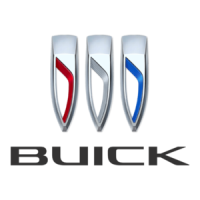
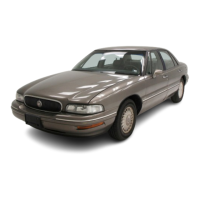
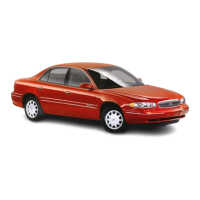
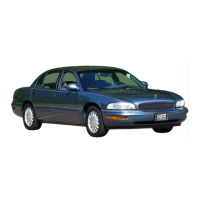


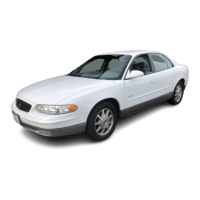
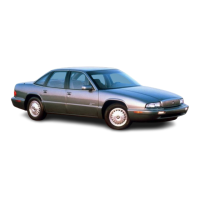
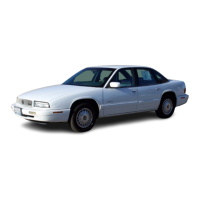


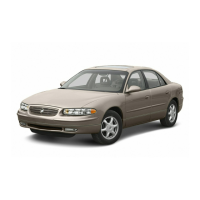
